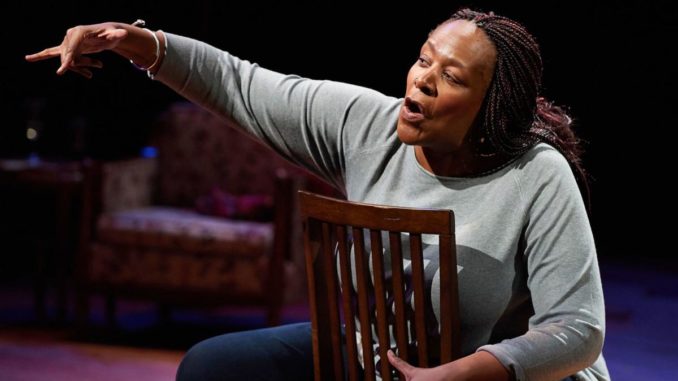
In the aftermath of the 2014 police shooting of Michael Brown in Ferguson, MO, the Repertory Theatre of St. Louis commissioned actress and playwright Dael Orlandersmith to chronicle the various community reactions. In a one-woman show in the vein of Anna Deavere Smith’s Fires in the Mirror and Twilight: Los Angeles 1992, Orlandersmith created a very moving piece of documentary theatre in Until the Flood, currently playing at the Kirk Douglas Theatre.
On a sparse set surrounded by ephemera meant to represent the various memorials left for Brown (deftly designed by Takeshi Kata), Orlandersmith embodies a number of individuals – black, white, male, female, young, old – to document the varied reactions to the shooting and its aftermath. In doing so, she highlights just how much race colors how people react to these altogether too frequent events. Using the interviews she compiled in Ferguson and the surrounding communities, she creates eight distinct composite characters – Louisa, a retired black teacher with deep roots in the community; Rusty a retired white Ferguson cop; Hassan, a 17-year-old black “thug;” Connie, a white school teacher; Ruben, an elderly black barber; Paul, a black high school student who lives in the same housing complex as Brown and wants to get out; Edna, a Universalist minister; and Dougray, a white man who rents houses in the black neighborhoods of Ferguson. Orlandersmith alternates perspectives, going from black to white and young to old, weaving not so much a tale as a rich portrait of a community whose fault lines are both deeply buried and simmering at the surface.
What makes this piece so compelling is Orlandersmith’s performance. She embodies these characters, using mainly her voice and body movements to disappear into each character (costume designer Kaye Voyce’s simple use of jackets and scarves and Mary Louise Geiger’s subtle lighting design brilliantly provide aid). Somewhat surprisingly, Orlandersmith seems to disappear completely into her portrayal of the male characters, especially Rusty, Hassan, and Dougray. These portrayals stand out in their vividness, and when the characters of Hassan and Dougray each take a decidedly dark turn, you can feel the palpable danger emanating off the stage.
On a bit of a personal note, this reviewer teaches high school in the inner city and the portrayal of Hassan was simply haunting. Orlandersmith so totally captured the anger, self-consciousness, and manic energy of many of my students that I had to remind myself she was simply portraying a character.
In the end Orlandersmith does not tie things up in a bow for the audience and we are left with the fragments of hatred, compassion, confusion, and acceptance that show just how fractured we are as a society and how far we have yet to go.
Brenna Guthrie
For tickets, go to centertheatregroup.org


Be the first to comment